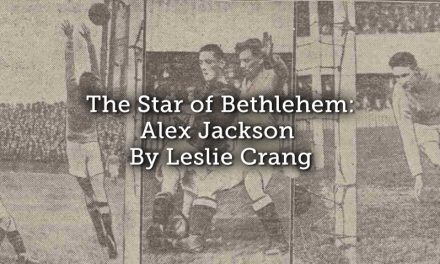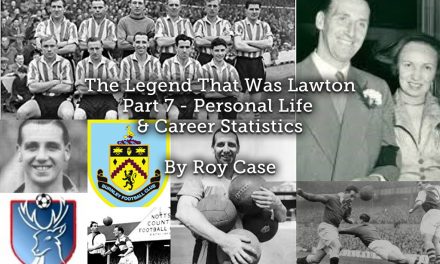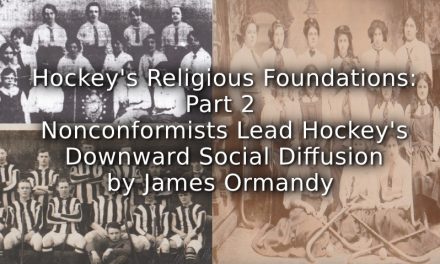Background
Both the title of the book and this slightly abridged chapter are nods to classic historical texts. This is a narrative-driven examination of the popularity of women’s football in England in and around 1921, based largely on original research into contemporary newspaper reports. From that, a database of revealed match data has been created which allows for a more detailed and rather different analysis of how the women’s game was developing in that momentous year which ended with the FA ban. Unusually it also sets the analysis in the context of what was happening in the men’s game at the time. The selected chapter below describes the position just before the ban came into force in December 1921.
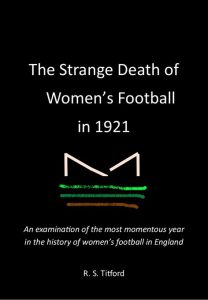
The structure of women’s football at the introduction of the FA ban
Among the difficulties facing the Football Association when considering the issue of women’s football was the basic question of with whom or what were they dealing. The women’s game had no formal organisation, no acknowledged and accountable spokesman or spokeswoman, and no clear and obvious purpose. The men’s game had, by and large, aided it on a piecemeal basis in the extraordinary circumstances of war and the enormous charitable needs immediately thereafter. This aid was not completely wholehearted, nor was it time limited.
In this interim period a few quite different plants had sprouted. Were they now to be weeded or cultivated? A taxonomy of what women’s football offered at the end of November 1921 would be as helpful now as it would have been back then. Today there is a widely held belief that the FA ban destroyed an emerging and potentially commercially successful women’s game. The purpose of this chapter is to test that hypothesis by examining the structure of women’s football at that point in time: what types of clubs existed, and how many; how were their identities created or rooted; how did they organise their fixture lists; what kinds of competitions did they have or aspire to; how was their development constrained by the existing practices of the men’s professional game.
In terms of numbers of clubs, Constance Waller of Huddersfield Atalanta estimated 28 in April 1921, and 150 is the number frequently cited for December 1921. Both could be correct, given the passage of time and the varying definition of what constituted a formal club. An analysis of the match data would suggest four types of club or women’s team. The width of this spectrum posed a problem for the survival of women’s football. In brief, the four types can be characterised as touring or exhibition teams, town teams, factory teams, and occasional or carnival teams.
Dick, Kerr Ladies (DKL) virtually have the touring category to themselves. One might possibly add St Helens, who almost never seemed to play a home match, and Plymouth International who, consciously or not, were copying the DKL model. The characteristics of this category were a focus on touring and international matches rather than cultivating home support, adding an international dimension to their fixtures where possible, higher status in terms of enjoying civic receptions and assemblies, liberal expenses and playing at major venues, attempting to raise substantial sums for charity, and having a player selection policy based on talent rather than institutional or geographic representativeness. It’s hard to find a parallel in the men’s game other than Corinthians who famously did not have their own home ground but toured widely and well with selective but amateur XIs. Sometimes they played for charitable causes and they retained their popularity, as a different kind of club, into the 1930s.
Next come the town teams, the likes of Fleetwood, Coventry, Stoke, Lancaster and Reading. Here the parallel is with what we might call men’s senior football as it emerged in the north in the 1880s and in the south in the early 1890s. These were clubs that took admission at the gate and needed to do so to subsidise the travel and hospitality costs for fulfilling fixtures outside their own town and district. The implicit aim was to represent the town to other towns on a regional or possibly national basis, and the implicit model was the clubs of the Football League. But at this stage these women’s teams were still very much amateur and had yet to develop a full season fixture list, or to secure their own grounds or a right to play regularly at a particular venue they could call home. Their financial focus was still largely charitable. One could reasonably add a small number of factory-originated teams – Heys and Listers of Bradford, Horrockses, Crewdson of Preston, Osram and Ediswan of London – to this category as they played matches, at least sometimes, on the scale of senior football and met town teams regularly. After all, factory teams like Thames Ironworks and Newton Heath Lancs and Yorks Railway FC grew into mighty clubs in the men’s game (West Ham and Manchester United respectively). When the Football League launched in 1888 it did so as a regional league (in reality) with a self-selected dozen clubs from a pool of about 20-30 viable candidates. Did the same opportunity exist for women in 1921? The numbers were there, it would seem, but not the financial viability (which had taken the men 5-10 years to establish) nor (with the exception of DKL) the financial imperative to pay professional or semi-professional players.
Third in the hierarchy come the factory, workplace or institutional teams existing in what we might call a junior football environment. Their geographic ambit would be local or inter-company, they would play for pleasure rather than charity and therefore not look to take gate money, and very often they would use company subsidised playing facilities. The Lyons of London clubs fit this profile quite well though they did make the occasional excursion elsewhere. In Bradford, there is some evidence of structured local level competition. Jean Williams, in ‘A Contemporary History of Women’s Sport’ (p199), notes the existence of a Bradford Ladies League for 1920-21 with 19 teams spread over two divisions and some associated cup competitions. The clubs’ origins were a mix of workplace, geography and institution. Williams quotes The Football Favourite magazine in April 1921, suggesting that the Yorkshire Ladies Football and Baseball Association was already in existence.
Finally, we have the occasional or carnival category. This was more important in terms of the public perception and image of the women’s game than in propelling it forwards in any way. One could easily suggest that far more press coverage was given to these matches than to the third category of more regularly played football. Prior to the 1860s football was rarely played on a regular basis but more often as part of a festival or community ritual. The sudden fashionability of women’s football in 1920 and 1921 inspired women to play as part of local charitable endeavours (perhaps we can see parallels in the 21st century with the upsurge in half-marathons and sponsored walks). These matches often formed part of a programme of events in a fete or carnival, rather than acted as stand-alone matches, and could include an element of misrule – unconventional costumes or some male players. In tone, the event could straddle the line between sport and pantomime and, as such, will have inhibited popular perceptions of women’s football as real sport.
So the presentation of women’s football in 1921 runs from de facto semi-professionalism played at a self-declared international level going quite quickly right down to first-timers playing in a park for a laugh; yet it is presented in a fairly even and undifferentiated way, partly because there was no structure to guide the reporting. Thus objections that could reasonably be levelled at each category or hierarchy of club leaked across the whole canvas of women’s football. The carnival category ridiculed the seriousness and manliness of football, while the touring category impinged on its much-valued financial probity and its important professional/amateur distinctions. In the middle, the town category might, in time, possibly offer a threat to attendances at professional men’s matches, while the factory teams gave the prospect of untrained female players over-exerting themselves to the detriment of their health, their employer and the image of the game as a whole. Of course, these objections were not all held and not held universally, and there was public support for women going their own way in the game.
What really transformed the men’s game from a regional sport to a national business within a decade was the league table. The Football League offered the first one in 1888-89 and within a few years there were regional leagues, local leagues, church leagues, schools leagues – not to mention Rugby League (1895) too. The league table is a hierarchy created from points and goal average and infused by the prospects of honour and failure. It takes all the months of blood, sweat, tears, mud, glory, pain, travel, scars, disappointment and exhilaration, and reduces it to a string of hard numbers. That string is precisely comparable to the many competitors and becomes the finite, ineradicable, historical record. The attraction of this phenomenon is probably more to the male psyche: learning by heart, interpreting, speculating upon, comparing, assessing, savouring, almost drooling over the new numbers lined up against the known names. Throughout the season, throughout the nation, every Saturday evening in hundreds of thousands of Sporting Pink newspapers, at their very beating heart were the latest league tables. Where are we now? Who’s on the up, who’s down the slide? These numbers kept interest and attendances high.
Women’s football in late 1921 did not have this beating heart. It was amorphous, unfixed, irregular, unpredictable as to its very happening or its club or county identities. Club credentials were vague, misleading or even false. Club records were incomplete and offered no comparative standing. Players could switch teams at a moment’s notice and back again. This lack of organisation was not an active and positive decision like the Corinthians’ ethos. It was a sign of an immature sport that was currently losing rather than gaining strength. Some women’s clubs could read the map, but they couldn’t afford the fuel to get on the road, literally as well as metaphorically.
There is a fragment in the Staffordshire Sentinel (12.11.1921), which reported the draw for the forthcoming Sheppard War Memorial Challenge Shield. Without any other known reference to this competition, one almost has to play the football archaeologist rather than historian here. The draw offered a North Section: Fleetwood v Bridgetts, Stoke a bye. And a South: Osram v Lyons, Reading v East Ham. All matches to be played for the benefit of charities and by 31 December 1921. The ‘sponsor’ is ET Sheppard, a monumental mason based in Henley-on-Thames. The teams involved make a degree of sense in status and geographic terms, though the absence of DKL and clubs from the south-west and Yorkshire is notable. However, who is to say that the aspiration was to be national rather than have a bit of competitive fun between like-minded clubs of comparable standing? The actual draw tells us that there was a network of contacts between clubs across the country, that someone – possibly Bridgetts judging by later evidence or Reading by the involvement of a local sponsor – was the organising principal, that there was a reluctance to pay for travel to the other end of the country except for the presumed North v South final, that geographically and work-based teams were happy to mix. Interestingly none of these clubs had played with any kind of frequency on the ground of a local Football League club so it is not necessarily the case that the ban on 5 December precluded these matches from taking place. As far as one can tell, none did. The Sheppard Shield was a stretch too far, even before the ban.
The key factors in developing a sound football structure were to have grounds that were available for regular play on Saturdays where gate money could be taken and having a sufficient number of opponents you could afford to play against, taking into consideration costs of travel, pitch maintenance, kit provision and so on. With the possible exceptions of Lancashire, the Potteries and West Yorkshire there was not a sufficient density of clubs within affordable reach. As the resources of, and prospective spectator appeal of, the women’s game did not stretch to investing in new or independently owned playing facilities, there was a reliance on facilities and goodwill elsewhere. And it was not as though there was a stack of available League grounds to be used on Saturdays during the season anyway, even before the ban. When the first team was away, the ground would typically be used by the Reserve team, and the gate money generated by the Reserve team was of significance to the Board of Directors, possibly comprising 10% of the season’s total.
The period from late March to June 1921 showed an extraordinary blooming of interest in women’s football. The period from September to November 1921 revealed that this was blossom, not roots, that fewer matches were being played, before lower crowds, at less prestigious venues, at a time when the general interest in (men’s) football was just as strong. Gail Newsham attempts a case for the defence, but it is mistaken and misleading. She writes, referring to this period it would seem, that, “A resentment was growing within the male soccer establishment due to the size of crowds women’s football and in particular the DKL were attracting … the uncomfortable truth was they were drawing bigger crowds than men”. She offers no corroboration for the first point and the second is plainly untrue. Using Brian Tabner’s ‘Through the turnstiles’, Newsham claims “the figures speak for themselves” (p93) but she mistakes every club’s average 1921-22 crowd figure for its largest individual gate, thus considerably aiding her case. For the 24 DKL matches, pre ban in 1921-22, for which data is available, DKL’s average crowd is in the region 7,000-7,500 – on a par with Accrington Stanley or Hartlepools United in the new Division Three (North). The average of the 22 Division One clubs’ averages was 29,400.
At its absolute peak – if we take DKL’s best 21 gates (clubs played 21 home league matches) only in England and Wales in the 1920-21 season – and calculate the average, the figure we reach is about 20,000. That is no more than the average of leading Division Two clubs like Sheffield Wednesday or West Ham – around the 25th best supported in the country. The average for all DKL matches would be significantly lower; there were more gates under 10,000 than over 20,000.
It is hard to say whether DKL, in particular, were ever taken really seriously as having genuine sporting merit. They received much praiseworthy comment and some favourable comparisons with male footballers of the time. Few contemporaries ventured to suggest at what level of men’s football they might have been competitive and it’s not easy to read across from the mixed results of their American tour when they played male teams. Undoubtedly, they were seen as remarkable within their own field, so remarkable it implied an utter competitive imbalance. The best of the French representative teams came close and the little-spoken of Mrs Vizard’s XI (aka Bolton Ladies) twice lost to DKL by just the odd goal. Unfortunately, the usual methods of testing sporting merit were not available to DKL.
There was no obvious public programme for the advancement of women’s football, and no effective or accepted public spokespersons or leadership for its cause. It was a grassroots movement out in the footballing wild, without structure or nurture. Women’s football as a spectator sport may have been ‘born’ in December 1920 and may have been in its infancy on 5 December 1921, but it was by no means a demonstrably healthy infancy.
Article © of Roger Titford
Book information
The Strange Death of Women’s Football in 1921 is available from the When Saturday Comes website at: shop.wsc.co.uk under Other Books and has its own Twitter handle @Women1921.

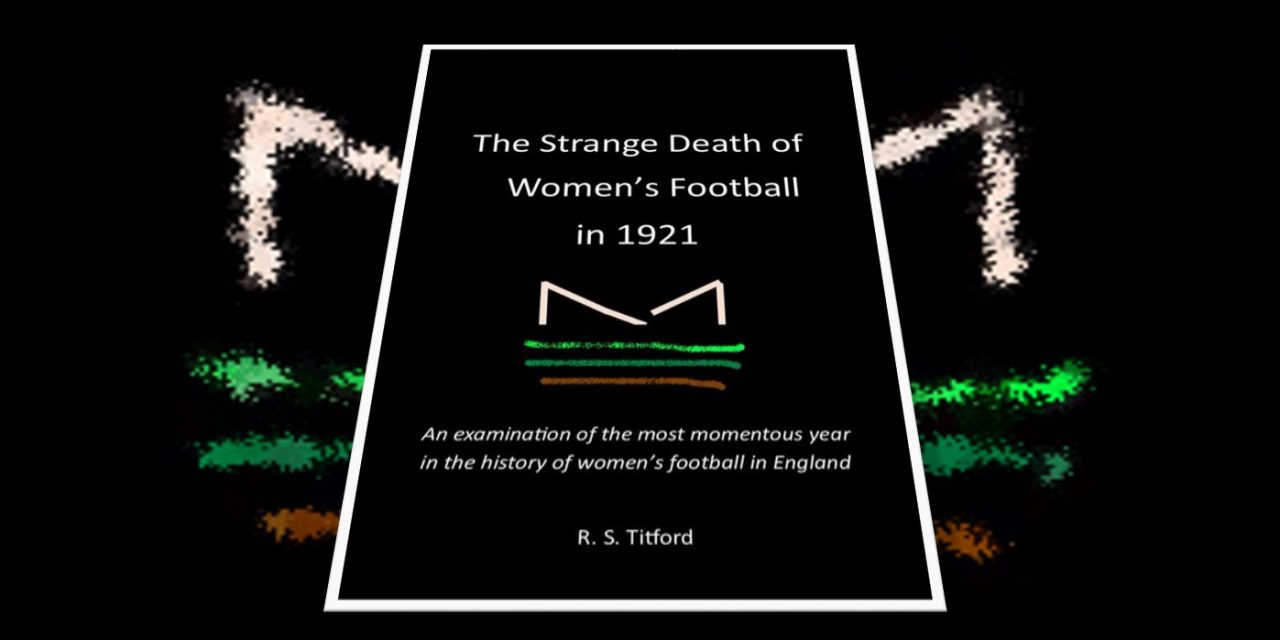
![The Eternal Seconds of Italian Women’s Athletics:<br>The History of Gruppo Sportivo La Filotecnica [Milan, 1935-1943]](https://www.playingpasts.co.uk/wp-content/uploads/2020/07/PP-banner-maker-3-440x264.jpg)
